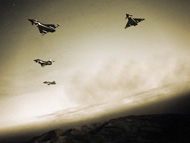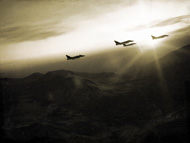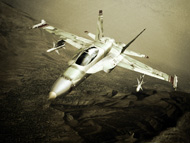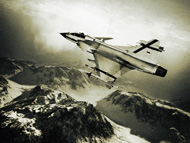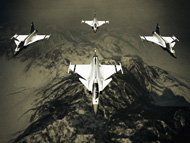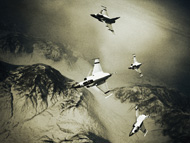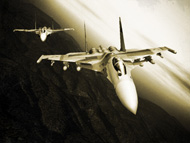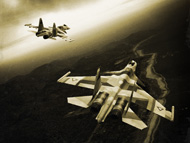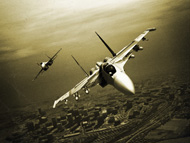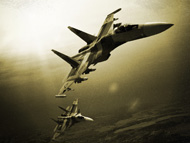First Edition
Belkan Air Power - First Edition was a Belkan Air Power issue published on July 3, 2005. It focused on the history of several aces of the Belkan Air Force.[1] Below is a translation of the original Japanese text.[2]
Colonel Detlef Fleisher
Detlef Fleisher was an ace pilot who carried with him the very same dignity as his TAC name—Stolz (pride)—suggests. Born in the capital city Dinsmark of the Principality of Belka, Fleisher was influenced by his military father and brother, and after graduating high school, he gained admission into Scheindel Military Academy without so much as a second thought, and began to walk the path of the soldier. This breathtakingly beautiful man was gifted not once but twice, having also a talent for bold and calm tactical thinking, immediately separating him from the crowd. His father, Heinz Fleisher, was a highly patriotic soldier, but never much of a thinker. Fleisher's tactical genius bloomed; not by bloodline but by the unceasing efforts borne of his own patriotism.
When Fleisher graduated at the top of his class at the academy, it was the Air Force to which he continued. The Air Force's position as crown jewel of the Belkan armed forces was due to the efforts of strategic information officer 1st Lt. Reinhard Dahl, who was in the Department of Air Force Information at that time. Though Fleisher was indeed invited to the Air Force, the man behind it was none other than Dahl. To Dahl, Fleisher was the embodiment of the propaganda image of Belkan armed forces (perhaps "Belkan Air Force" would be more appropriate), combining strong patriotism, a beautiful appearance, and genius as a soldier, all into one man. However, Dahl made one misjudgment: Fleisher strongly desired to be a fighter pilot on the furthest front lines. Fleisher's patriotism made it his priority to serve the Fatherland with his own flesh and blood. Soon enough, his canniness manifested as a fighter pilot as well. He brought his genius to the sky, and his potential for growth was said to be limitless. 1st Lt. Dahl revealed years later that he felt numb every time his useful billboard (Fleisher) made it back from a dangerous battlefield.
Fleisher's battle records begin on May 10, 1994, with the downing of three Su-27s affiliated with the Republic of Ustio in the skies over Area B7R. His characteristic ability to calmly analyze pushed him upwards towards the position of top ace. He shot down five F-16Cs in two sorties on May 15, 1994. He was awarded the Belkan Silver Cross, and within the country he was greatly publicized for his military exploits as the "Red Swallow". Those who knew him are unanimous in saying Fleisher himself had an immense consciousness of his duty as a propaganda tool – a "responsibility which only I can carry out". His "Rot Team"—known widely not only within the Air Force but among the armed forces in general—was sensationalized within the country under its military leadership, and enlivened the papers in the early stages of the Belkan War. As he became more prominent as an ace pilot, occasionally people around him would work to move him from the forward edge of battle to the safe rear lines. However, Fleisher stubbornly wished to contribute to the front lines. However, even as Fleisher's kill count steadily increased, he himself was shot down in B7R on April 20th 1995. Perhaps in that moment, something which had been under stress broke. The invincible young ace fell to the ground, and chose the path of an officer – a base commander. He was tried as a war criminal after the war, but avoided immediate punishment. Afterwards he remained within Belka, and lives on as a professor of history at Dinsmark University.
Captain Bernhard Schmidt
A curbside speech by a party member grabbed one man by the heart, and hurled him into the great blue sky. This man's name was Bernhard Schmidt. Called the "owl-eyed man", he came to be feared by pilots of neighboring countries as one of the pilots most representative of the Belkan Air Force. However, his career differed greatly from those of the so-called elite. Schmidt was born in downtown Sudentor, and as such, he was never graced by privilege. His environment and lifestyle brought him into contact with the darker parts of society. As a brooding thug, his hands were at times stained by dirty work, and at times with dirty money – this is how he passed the days until 1990. However, there one day came a turning point. That was the day when a speech given by the ascendant ultra right wing Belkan Liberal Democratic Party pierced so neatly through that heart of his which ever sought for something to believe in.
His patriotism awakened, Schmidt joined Belka's crown jewel: the Belkan Air Force. Contemporary Belkan propaganda was ingenious, and there was no end to applicants like Schmidt. To put it to words, what elevated Schmidt from the crowd to the level of ace pilot was his superb gift for grasping a situation. Just as he took to heart the art of surviving among the dregs of society, so too did he apply his usual cunning to surviving the skies. His eye for reading the tide of battle was excellent, and it made him always sensitive to perceiving the "flow" of a battlefield beyond what the HUD and instruments showed. During a sortie on March 21, 1994, it's recorded that he faced off against an F-15C on equal footing while his electronic instruments were disabled due to battle damage, and eventually shot it down. This alone speaks volumes to his incredible skill.
Further, one can't speak about Schmidt without touching upon all the members of Grun Team, which he led. The Belkan Air Force was an organization that combined strict discipline on the one hand with a profound accumulation of talent on the other. Grun was the squadron where all the skilled troublemakers of the 10th Air Division who had accrued scores of regulatory violations were gathered. All the pilots were problem children whose commanders had thrown up their hands in despair, but it's also said that from among the many pilots who lived fast and furiously to win feats of arms, these men came together to focus on survival.
The concept was outside the box. Their doctrine was odd even within the Belkan Air Force, but there's no doubt that the Belkan Air Force's flexibility, to the extent that they were able to incorporate Grun into their organization, was one of the reasons for their strength.
Grun Team's tactics in battle were to run down their targets, changing their formation on the fly according to the situation, never keeping a clear shape. One may doubt the word "tactical" applies to this way of fighting, but when each member one by one, starting with Schmidt, demonstrated their eye for reading a situation, Grun Team developed an analytical way of fighting. With surviving numerous battlefields his imperative, Schmidt's constant migrations over the theater brought with them bright accomplishments. He returned numerous times to behind friendly lines after having been shot down over B7R by Republic of Ustio fighters, his score of victories over Allied Forces aircraft continuing to accumulate. Eventually, his stubborn nature never having let him become a fallen soldier, he lived past the war's end and returned to his hometown of Sudentor. Since then there has been no news of him.
1st Lieutenant Dimitri Heinreich
Heinreich, called the "blue heron", is known as the alpha wolf of the eastern front. With 54 total confirmed kills, there can be no argument that this record makes him one of the top aces of the Belkan War. He was born into the House of Heinreich, an aristocratic bloodline passed down from Belkan knights. During the Middle Ages, they exerted a great influence over the Belkan court in both politics and war. In the modern era, the House of Heinreich has transitioned with success to the world of international trade, using their remaining substantial ties to the world of politics and business to conduct their family trade.
The House of Heinreich had officially recused themselves from the world of military affairs, but their strength and pride as Belkan knights was inherited under the surface through to the present day. It was not at all strange when the man born as the fourth son joined the military out of his patriotic desire to uphold Belkan righteousness.
Heinreich, whose talent for the art of aerial combat bloomed from early on, steadily increased his kill score, and in 1988 was promoted to the rank of colonel seven years after instatement. During the regime change following the ascension of the far right Belkan Liberal Democratic Party in 1992, it's said that a faction centered around the old Belkan nobility strengthened their influence over the military. However, it was not by dint of his birthright but rather by his own skill that he ascended the throne of top ace. From his first sortie to the end of the war, he continued to mount his JAS-39C time and again. The superlative acceleration performance of the JAS-39C met the demanding requirements of the tactics by which he led Indigo Team. The "indigo cross" borne also by the Belkan knights was painted vividly upon their white wings.
What catapulted him into fame was the battle for Model on the border of Gebet on the eastern front, taking place on March 27, 1995. It's said that in the span of five minutes after engaging a squadron of F-14Ds from the Republic of FATO (said to be the 3rd Air Division 122nd Squadron), his Indigo Team shot down 9 planes. The countries located on Belka's eastern borders were regions which Belka subjugated in the opening stage, and with countries like FATO and Gebet unable to form a line of resistance, they fell one by one. As a result, it was the ideal place and time for the Belkan Air Force located on the eastern front to accumulate kills. It's said that the Belkan Air Force was nearly 20 years more advanced than the low quality air forces of the countries located on Belka's eastern side. In this regard, it might be said that Indigo Team was lucky. When Heinreich was promoted to colonel, he was appointed head of the 51st Squadron. Reliable as always, he fastidiously performed his desk work as his kill score stretched ever onwards.
However, on April 20, 1995, he was ordered on a sortie to Area B7R, away from the air defense of the eastern front. Indigo Team had already experienced air battles over B7R countless times (they racked up a respectable score over B7R as well), but Heinreich's life as a pilot came to an end. Shot down by an Allied Forces squadron, he escaped death but sustained a life-threatening injury, and he floated unconscious in the space between life and death for three months. When he opened his eyes after a three-month coma state, the war had already concluded, and he left the armed forces.
Today it's said that he spends his life managing the family's trading company.
Colonel Orbert Jager and 1st Lieutenant Rainer Altman
Until April 1995, southern Belka, where they maintained superiority, was their line of defense, but since the major Allied Forces offensive beginning on April 23rd, that strength had been ebbing. The 23rd Tactical Fighter Squadron's Gelb Team is regarded as one of the squadrons which contributed to this strength during the opening phase. Gelb Team was comprised of two ace pilots: Orbert Jager and Rainer Altman. Long time partners, Jager and Altman were an excellent pair who complemented each other's abilities, and because of this, racked up a large score on the southern front. The two plane formation was very strange in the Belkan Air Force at the time, but their results as a pair greatly exceeded those of traditionally organized flights in combat effectiveness. The Belkan Air Force considered this fact in a clinical manner, and it was just this flexibility to incorporate special organizations that the Air Force was built around in the first place.
As opposed to the eastern front where air supremacy had been established, the situation on the southern front was fluid. Until the Allied Forces offensive operation of April 23 began to tilt the situation in their favor, a stalemate persisted. The results Gelb obtained during this period were impressive, but this situation was supported by infeasible logistical operations. Because of this, the baleful effects of Belka's over-expansion of the southern front came to a head during the middle phase of the Belkan War, and on many portions of the front line, logistics operations came to a standstill. The stretched lines to the rear were often thin and broken, and guaranteeing enough combat strength to maintain the front became exceedingly difficult.
Gelb was deployed to the base in Thionville within central southern Belka, where it's said that they sometimes sortied five times a day holding the front lines. Such hand-to-mouth operations spurred the transition from offense to defense on Belka's southern front. Yet, even in the midst of this, Jager and Altman continued to rack up a score. Compared to the eastern front, from which many ace pilots who earned high kill counts came, the skies of the southern front had a reputation for being unspectacular, but this state of affairs was supported by rough pilots like Gelb Team. It may be impossible to equate the scores of the eastern front with those of the southern front in the same terms.
Jager and Altman joined the ranks of ace pilots by placing their lives on the line in the unforgiving southern front, repeatedly flying tightrope-like sorties, yet the final mission would come for them as well. On May 13, 1995, Gelb Team was charged with preventing the liberation of Ustio's capital. As they flew towards Directus airspace, they entered into an air battle with Ustio's air service over the suburbs. The result: Jager's death, and Altman's rescue by a local parent and child after crashing – saving his life. Afterwards, Altman didn't return to Belka, but remained in Directus as a writer. His novelized account of the war, which he'd been writing as a hobby since enlistment, became a bestseller. He's currently writing a sequel.
Trivia
- In Gelb's section, the date of Offensive Campaign No. 4101 is stated as April 23, 1995. However, The Round Table took place on April 20, and Juggernaut took place on April 24.
References
- ↑ ACE COMBAT Zero -> World -> World News -> World News 12.
- ↑ First Edition. Encyclopaedia Strangereal. Retrieved on March 8, 2018.



